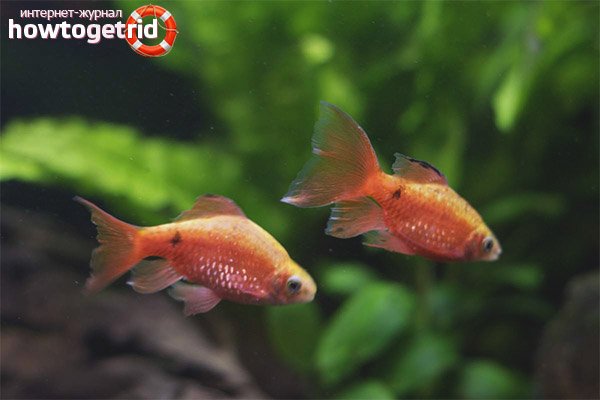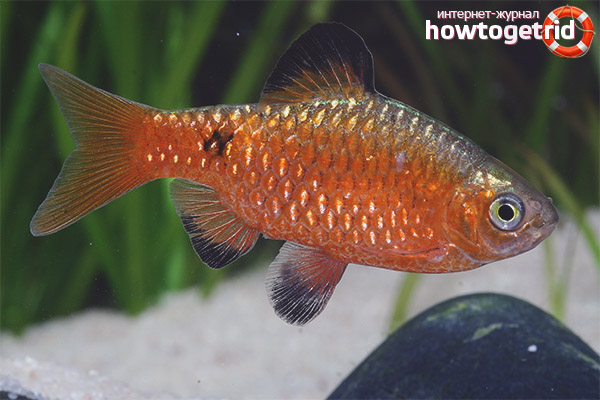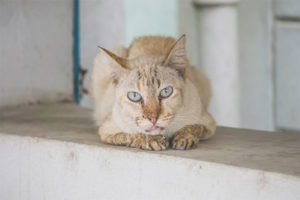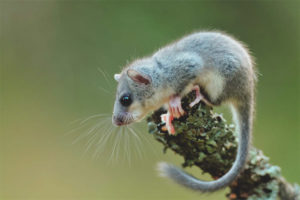The content of the article
Such a water inhabitant as the Fiery barbus is a very beautiful and bright fish of the barbus family. The features of this fish include its low demands on the conditions of detention. This aquarium inhabitant gets along well with his neighbors and it is very interesting to watch him. The fish is very nimble and active, which makes it one of the most popular species among beginner aquarists.
Although the barbs have a beautiful and eye-catching color, the latter becomes most spectacular during the spawning period. It was during this period that the color of the males of the barbus became as bright as possible - the body color of the fish became bright red with characteristic tints of a golden hue, resembling tongues of flame. Thanks to such an original natural color, the fish got its name - the fire barbus.
As mentioned, this beautiful aquarium fish is not whimsical in content, but is very active and able to surprise with its spectacular and extraordinary appearance. One of its features is that under natural conditions it can live in fairly cool water, the temperature indicators of which are about 18-22 ° C. Therefore, when choosing neighbors for a fire barbus, this moment should be taken into account.
Natural habitat
The first mention of such a fish species as barbus came to us thanks to the wildlife researcher Hamilton, who described this species in 1822. Their homeland is India, and it can often be found in Singapore.
Note that the appearance of the barbus may vary slightly, it all depends on its habitat. For example, the Indian and Bengal fire barbs have a more saturated color and bright, glare-blinding scales.
The direct habitat of the fiery fish is various natural reservoirs, both large and very modest in size. The main food of the barbus is detritus, algae, small insects.
View description
In the natural environment, this species of fish grows to a fairly large size (at least 15 cm), in the conditions of life in an aquarium, the size of a barbus rarely reaches 10 cm. The average life of a fire barbus is 5-6 years.
The color of the fish is spectacular - silver-golden. Males have a characteristic difference - a reddish abdomen, fins and sides. A feature of this type of fish is the presence of a black dot near the caudal fin.
Features and difficulties that should be considered when maintaining a barbus
Presented to the attention of the fish - this is the best solution for beginner aquarists. This is because this species perfectly tolerates even a fairly frequent change of place of residence, they are unpretentious in care and nutrition. An important condition for their maintenance is the cool water in the aquarium, as well as the selection of neighbors for these aquatic inhabitants, taking into account the required temperature parameters of the water. It should also be borne in mind that, although barbs and benevolent and peaceful fish, nevertheless, they often notice such a feature as the breakage of fins in other species. Therefore, select neighbors for a barbus with small fins.
Feeding Features
The fiery barbus is not a demanding fish, and therefore can eat all the feeds offered to it by the owner: artificial, live and frozen. In feeding, diversity is desirable, which will help maintain activity and the immune system. For example, special flakes with additional top dressing with live food (artemia, bloodworms, etc.) can be used as the basic basis of the fish diet.
Home Aquarium Maintenance
This rybka of the barbus family is quite large; for swimming, it selects all layers of water in the aquarium in which it lives. It is best to keep the barrels in small flocks, since it is in the society of its relatives that this species reveals all its characteristic features. The aggression towards other species living in the neighborhood is also markedly reduced. The minimum number of fish that should be in the barbel saiga is 6-8 individuals. Accordingly, for this you need to choose a rectangular aquarium that is suitable in size - a volume of at least 80 liters.
Another important condition for the content of fire barbs is the presence of a lid on the aquarium, this is necessary to prevent the death of the fish, which can jump out of the water.
In addition to the necessary temperature parameters of water, you should also take care of a small flow, for this you can use a special filter. Water changes should be carried out weekly.
The soil in the aquarium should be of medium softness, it is also necessary to have dense vegetation and snags. Especially spectacular fish look in sunlight, so the best place to place the aquarium would be a stand near the window.
Compatibility with other types

As mentioned above, the fire barbus is a fairly mobile and active fish, which is very interesting to observe. As for its compatibility with other species - it gets along well with almost all of its neighbors. Note that, choosing neighbors for a barbecue, it should be borne in mind that such a fish should also be quite active and prefer cool water for life. For example, it can be panda catfish or cardinals.
Gender differences
Until the male reaches maturity, it is practically impossible to distinguish him from the female. Adult individuals have more pronounced differences between themselves. This is manifested by a brighter and more spectacular color of the male. In females, the abdomen has more rounded shapes and sizes.
Propagation Features
The process of propagation of the fire barbus is quite simple and not particularly difficult. Therefore, even beginners can engage in the breeding of fish of this species.
For spawning, you should choose an aquarium or tank with a volume of at least 30 liters. Water in such an aquarium should have a temperature slightly higher than in a normal one - up to 25 ° C.
The beginning of spawning is accompanied by the beginning of mating games between the female and the male, which at this time acquires the most saturated color. During spawning, the female, as a rule, lays several hundred eggs, the fertilization of which is done by the male. We draw attention to the fact that immediately after spawning, the fish should be planted, they can begin to feed on laid eggs.
After a day, a larva appears, on the third day, a fry. The fry are fed with small feed - micro-quench, infusoria. As they grow, larger feeds are introduced for feeding - artemia, naupilia.
Video: aquarium fish fire barbus










Submit